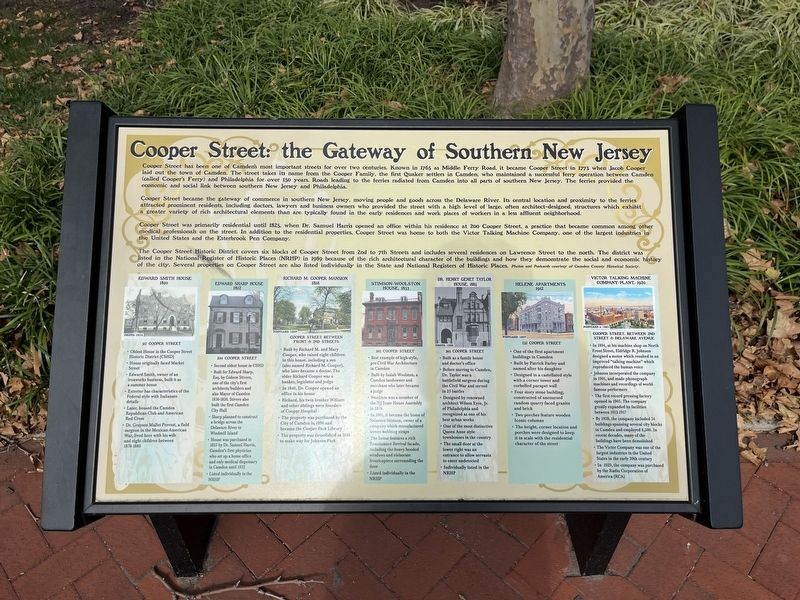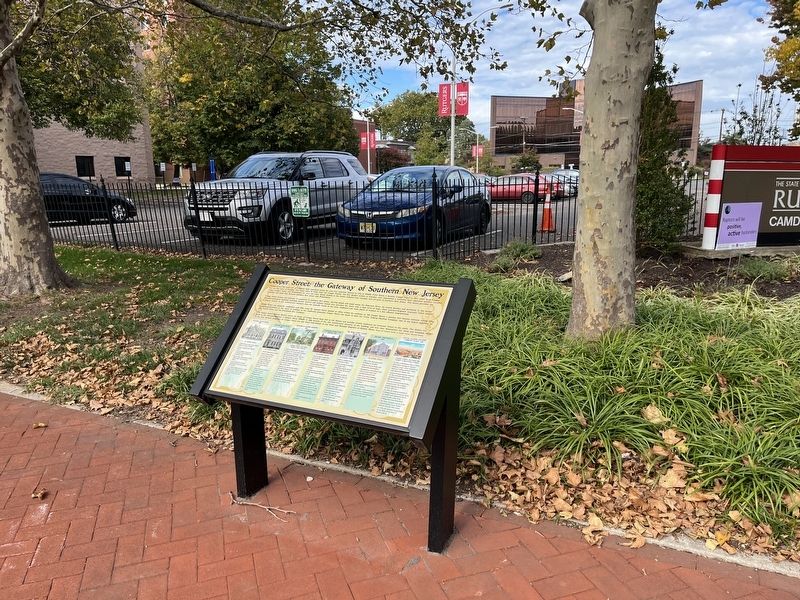Cooper Grant in Camden in Camden County, New Jersey — The American Northeast (Mid-Atlantic)
Cooper Street: the Gateway of Southern New Jersey

Photographed By Devry Becker Jones (CC0), October 16, 2022
1. Cooper Street: the Gateway of Southern New Jersey Marker
Cooper Street has been one of Camden's most important streets for over two centuries. Known in 1765 as the Middle Ferry Road, it became Cooper Street in 1773 when Jacob Cooper laid out the town in Camden. The street takes its name from the Cooper Family, the first Quaker settlers in Camden, who maintained a successful ferry operation between Camden (called Cooper's Ferry) and Philadelphia for over 150 years. Roads leading to the ferries radiated from Camden into all parts of southern New Jersey. The ferries provided the economic and social link between southern New Jersey and Philadlephia.
Cooper Street became the gateway of commerce in southern New Jersey, moving people and goods across the Delaware River. Its central location and proximity to the ferries attracted prominent residents, including doctors, lawyers and business owners who provided the street with a high level of large, often architect-designed structures which exhibit a greater variety of rich architectural elements that are typically found in the early residences and work places of workers in a less affluent neighborhood.
Cooper Street was primarily residential until 1825, when Dr. Samuel Harris opened an office within his residence at 200 Cooper Street, a practice that became common among other medical professionals on the street. In addition to the residential properties, Cooper Street was home to both the Victor Talking Machine Company, one of the largest industries in the United States and the Esterbrook Pen Company.
The Cooper Street Historic District covers six blocks of Cooper Street from 2nd to 7th Streets and includes several residences on Lawrence Street to the north. The district was listed in the National Register of Historic Places (NRHP) in 1989 because of the rich architectural character of the buildings and how they demonstrate the social and economic history of the city. Several properties on Cooper Street are also listed individually on the State and National Registers of Historic Places. Photos and Postcards courtesy of Camden County Historical Society.
Edward Smith House Oldest House in the Cooper Street Historic District (CSHD)
1810
312 Cooper Street
House originally faced Market Street
Edward Smith, owner of an ironworks business, built it as a summer house
Exterior has characteristics of the Federal style with Italianate details
Later, housed the Camden Republican Club and American Red Cross
Dr. Grayson Mallet-Prevost, a field surgeon in the Mexican-American War, lived here with his wife and eight children between 1878-1880
Edward Sharp House Second oldest house in CSHD
1812
200Cooper StreetPhotographed By Devry Becker Jones (CC0), October 16, 20222. Cooper Street: the Gateway of Southern New Jersey Marker
Built for Edward Sharp, Esq. by Gideon Stivers, one of the city's first architects/builders and also Mayor of Camden 1830-1838. Stivers also built the first Camden City Hall
Sharp planned to construct a bridge across the Delaware River to Windmill Island
House was purchased in 1825 by Dr. Samuel Harris, Camden's first physician who set up a home office and only medical dispensary in Camden until 1932
Listed individually in the NRHP
Richard M. Cooper Mansion Built by Richard M. and Mary Cooper, who raised eight children in this house, including a son (also named Richard M. Cooper), who later became a doctor. The elder Richard Cooper was a banker, legislator and judge
1816
Cooper Street between Front & 2nd Streets
In 1840, Dr. Cooper opened an office in his house
Richard, his twin brother William and other siblings were founders of Cooper Hospital
The property was purchased by the City of Camden in 1898 and became the Cooper Park Library
The property was demolished in 1910 to make way for Johnson Park
Stimson-Woolston House, 1853 Best example of high-style, pre-Civil War Architecture in Camden
303 Cooper Street
Built by Isaiah Woolston, a Camden landowner and merchant who later became a judge
Woolston was a member of the NJ State House Assembly in 1878
In 1861, it became the home of Solomon Stimson, owner of a company which manufactured woven webbing straps
The house features a rich Renaissance Revival facade, including the heavy hooded windows and elaborate fronticepiece surrounding the door
Listed individually in the NRHP
Dr. Henry Genet Taylor House, 1885 Built as a family house and doctor's office
305 Cooper Street
Before moving to Camden, Dr. Taylor was a battlefield surgeon during the Civil War and served in 25 battles
Designed by renowned architect Wilson Eyre, Jr. of Philadelphia and recognized as one of his best urban works
One of the most distinctive Queen Anne style townhouses in the country
The small door at the lower right was an entrance to allow servants to enter undetected
Individually listed in the NRHP
Helene Apartments One of the first apartment buildings in Camden
1912
232 Cooper Street
Built by Patrick Farley and named after his daughter
Designed in a castellated style with a corner tower and corbelled parapet wall
Four story stone building, constructed of uncoursed random quarry faced granite and brick
Two porches feature wooden Iconic columns
The height, corner location and porches were designed to keep it in scale within the residential character of the street
Victor Talking Machine Company Plant, 1920 In 1894, at his machine shop on North Front Street, Eldridge R. Johnson designed a motor which resulted in an improved "talking machine" which reproduced the human voice
Cooper Street, between 2nd Street & Delaware Avenue
Johnson incorporated the company in 1901, and made phonograph machines and recordings of world-famous performers
The first record pressing factory opened in 1905. The company greatly expanded its facilities between 1912-1917
By 1928, the company included 34 buildings spanning several city blocks in Camden and employed 8,500. In recent decades, many of the buildings have been demolished
The Victor Company was one of the largest industries in the United States in the early 20th century
In 1929, the company was purchased by the Radio Corporation of America
Topics and series. This historical marker is listed in these topic lists: Architecture • Churches & Religion • Industry & Commerce • Roads & Vehicles • Science & Medicine • Settlements & Settlers • Waterways & Vessels. In addition, it is included in the Quakerism series list. A significant historical year for this entry is 1765.
Location. 39° 56.854′ N, 75° 7.414′ W. Marker is in Camden, New Jersey, in Camden County. It is in Cooper Grant. Marker is at the intersection of Cooper Street and North 3rd Street, on the right when traveling west on Cooper Street. Touch for map. Marker is at or near this postal address: 303 Cooper St, Camden NJ 08102, United States of America. Touch for directions.
Other nearby markers. At least 8 other markers are within walking distance of this marker. The Cooper Family (within shouting distance of this marker); The Edward Sharp House (about 300 feet away, measured in a direct line); Cooper Street Historic District (about 400 feet away); The New Jersey Safe Deposit and Trust Company Building (about 400 feet away); One John F. Gerry Plaza (about 500 feet away); Jeremy Kane (about 600 feet away); W. Layton Hall (about 600 feet away); Enslaved Africans Once Sold Here (about 700 feet away). Touch for a list and map of all markers in Camden.
Credits. This page was last revised on April 23, 2023. It was originally submitted on October 20, 2022, by Devry Becker Jones of Washington, District of Columbia. This page has been viewed 146 times since then and 21 times this year. Photos: 1, 2. submitted on October 20, 2022, by Devry Becker Jones of Washington, District of Columbia.
